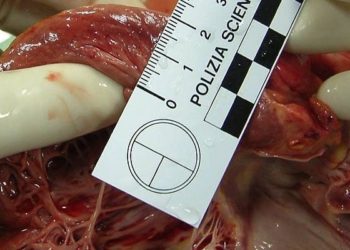Combo angiotensin-neprilysin inhibitor superior to enalapril in heart failure [PARADIGM-HF trial]
1. LCZ696 is a novel drug that combines the neprilysin inhibitor, sacubitril, and the angiotensin receptor blocker (ARB), valsartan.
2. In patients with heart failure with reduced ejection fraction, LCZ696 was more effective than enalapril in preventing cardiovascular death and hospitalization.
Evidence Rating Level: 1 (Excellent)
Study Rundown: Over 6 million Americans suffer from heart failure, with half of those from systolic heart failure, or heart failure with reduced ejection fraction, and the other half with heart failure with preserved ejection fraction. The current standard of care consists of an angiotensin converting enzyme (ACE) inhibitor, beta-blocker, and the addition of an aldosterone antagonist as needed. ARBs are used in patients who are unable to tolerate ACE inhibitors.
Natriuretic peptides reduce vasoconstriction and sodium retention and are secreted from the heart, kidneys, vasculature, and the central nervous system during heart failure. These natriuretic peptides are degraded by neprilysin. Previous studies have shown that the inhibition of neprilysin leads to an increase of these peptides, thus reducing vasoconstriction and sodium retention. Additionally, the combination of neprilysin and ACE inhibition has been shown in animal studies to be more effective than either therapy alone. However, in clinical trials (OVERTURE and OCTAVE), patients experienced severe angioedema when treated with both drugs together. Promisingly, the combination of an ARB with a neprilysin inhibitor was found to be more effective than ARB alone in treating patients with hypertension and heart failure with preserved ejection fraction.
The PARADIGM-HF (Prospective Comparison of ARNI [Angiotensin Receptor–Neprilysin Inhibitor] with ACEI [Angiotensin-Converting–Enzyme Inhibitor] to Determine Impact on Global Mortality and Morbidity in Heart Failure Trial) sought to assess whether the combination of an ARB with neprilysin inhibition was more effective than ACE inhibition alone in class II-IV heart failure patients with reduced ejection fraction. After 27 weeks, the authors found a significant reduction in the rate of cardiovascular death and hospitalizations in patients treated with LCZ696 as compared to the ACE inhibitor, enalapril. This five year phase III trial is the largest trial to date in the evaluation of heart failure therapy. These tremendously positive results suggest that LCZ696 may be a novel therapy in the treatment of heart failure, the first in almost a decade.
Click to read the study, published today in NEJM
Click to read the accompanying editorial in NEJM
Relevant Reading: The angiotensin receptor neprilysin inhibitor LCZ696 in heart failure with preserved ejection fraction: a phase 2 double-blind randomised controlled trial
In-Depth [randomized controlled trial]: This randomized, double-blinded trial consisted of 8442 patients with NYHA class II-IV heart failure with an ejection fraction of 35% or less. Patients received either LCZ696 or enalapril treatment daily. The primary outcome was death from cardiovascular causes or hospitalization for heart failure. Prior to randomization, all patients underwent a run-in period where tolerance to both medicines were assessed. The trial was stopped early, after 27 months due to overwhelming benefit of the study drug.
At trial stoppage, death from cardiovascular causes or hospitalization for heart failure occurred in 914 patients (21.8%) in the LCZ696 group and 1117 patients (26.5%) in the enalapril group (hazard ratio 0.8 in the LCZ696 group; p<0.001). Death due to cardiovascular causes was reduced by 20% with LCZ696 treatment, from 16.5% in the enalapril group to 13.3% in the LCZ696 group (hazard ratio 0.80; 95% CI, 0.71 to 0.89; p<0.001). Hospitalizations were reduced by 21% with LCZ696 treatment, from 15.6% in the enalapril group to 12.8% in the LCZ696 group.
Symptomatic hypotension was more present in the LCZ696 group, though cough and hyperkalemia were reduced. Compared to the enalapril group, fewer patients in the LCZ696 group stopped their study medication because of an adverse event (12.3% vs. 10.7%, p=0.03) or because of renal impairment (1.4% vs. 0.7%, p=0.002).
More from this author: Oral RSV entry inhibitor effective at reducing viral load and clinical symptoms, Bedaquiline efficacious in treating multidrug resistant tuberculosis: phase 2 trial, Transfusion therapy linked with reduced neurovascular disease in sickle cell anemia
Image: PD
©2012-2014 2minutemedicine.com. All rights reserved. No works may be reproduced without expressed written consent from 2minutemedicine.com. Disclaimer: We present factual information directly from peer reviewed medical journals. No post should be construed as medical advice and is not intended as such by the authors, editors, staff or by 2minutemedicine.com. PLEASE SEE A HEALTHCARE PROVIDER IN YOUR AREA IF YOU SEEK MEDICAL ADVICE OF ANY SORT.





![Ivabradine ineffective in stable coronary artery disease [SIGNIFY trial]](https://www.2minutemedicine.com/wp-content/uploads/2014/09/800px-RCA_atherosclerosis-75x75.jpg)

